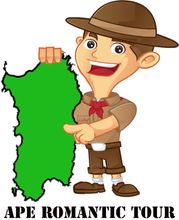Olbia city tour by Tuk Tuk
Olbia has a very ancient history, which is evident from the monuments and archaeological remains. These were left by the Nuragic civilisation, the Phoenicians, the Greeks and the Romans, who chose to create and develop this city on the north-eastern coast of Sardinia.
If you would like to explore the city in an original and creative way, try our scenic Tuk-Tuk tour, which includes five stops. This will give you the opportunity to visit and admire the city like a local.
Onboard our Tuk-Tuk, you will navigate the narrow streets of the historic centre and discover the monuments and attractions included in the itinerary:
The Basilica of S.Simplicio, an imposing Romanesque church made entirely of granite, its origins date back to three construction periods throughout the 11th and 12th centuries.
The Church of S. Paolo, which is located in the city centre. Its construction began in the 17th century but was not completed until the 18th century. It is made entirely of granite and is renowned for its beautiful dome, which is decorated with multicoloured majolica.
The historic centre of Olbia
and its main street "Corso Umberto," which is dotted with early twentieth-century buildings, traditional shops, boutiques, as well as restaurants and bars - perfect for a delicious break . We will travel by Tuk-Tuk down the ancient streets located either side of the main street and will pass close by the eighteenth-century houses.
The "Fausto Noce" Park, the green lung of the city of Olbia is eighteen hectares in total, making it the largest natural park in Sardinia. In 2005, it was awarded second place for the best green project in Italy. The park is home to many species of Mediterranean vegetation and has benches, fitness trails, sports facilities (tennis and soccer fields), an amphitheatre, fountains and artificial lakes.
WE WILL TAKE YOU WHERE YOU DREAM TO GO
Departure/Return
Olbia - Molo Brin Parking Lot
(It is possible to organise a hotel pick-up at an extra cost, only upon request)
Itinerary
- Panoramic view of the historic centre
- Stop at the Church of S.Paolo (5 min)
- Panoramic view of Lungomare
- Panoramic view of the port of Olbia
- Stop at the Fausto Noce Park (10 min)
- Panoramic view of Via Gabriele D'Annunzio
- Stop at the Basilica of S.Simplicio (5 min)
- Return to the pickup location
Audio Guide
Italian, English, Spanish, French, German.
Clothing
Dress comfortably, bring a cardigan to enter the churches, don't forget:
- A Camera
- Water
Cancellation Policy
- You will receive a full refund if you cancel at least 24 hours before the tour departure.
- You will receive a full refund if the tour is canceled due to bad weather.
- The refund is made directly to the credit/debit card used for the booking.
Prices
Adult (aged 8-100)
Child (aged 3-7)
Infants (0-2 years): Not allowed
Please Note
If you only have a limited time for your stay in Olbia, you can book a small 30-minute city tour without stops.
Adults (aged 8-100); Child (aged 3-7)

















